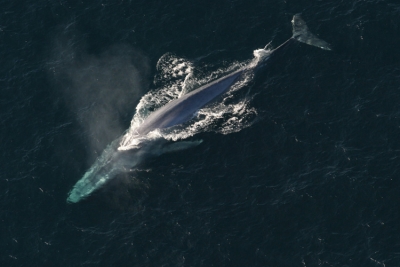
Blue whales’ average lifespan is estimated at around 80 to 90 years. Scientists can estimate the age of whales by counting the layers of wax-like earplugs collected from deceased animals.
Scientists know little about the life history of the blue whale. The best available science suggests the gestation period is approximately 10 to 12 months. Weaning probably occurs at around 6 to 7 months on, or en route to, summer feeding areas. The age of sexual maturity is thought to be 5 to 15 years. Most reproductive activity, including births and mating, takes place during the winter. The average calving interval is probably 2 to 3 years.
Blue whales are found in all oceans except the Arctic. They generally migrate seasonally between summer feeding grounds and winter breeding grounds, but some evidence suggests that individuals in certain areas might not migrate at all. Information about distribution and movement varies with location, and migratory routes are not well known. In general, distribution is driven largely by food availability—they occur in waters where krill are concentrated.
In the North Atlantic Ocean, their range extends from the subtropics to the Greenland Sea. Blue whales have been sighted in the waters off eastern Canada and in the shelf waters of the eastern United States.
Along the West Coast of the United States, eastern North Pacific blue whales are believed to spend winters off of Mexico and Central America. They likely feed during summer off the U.S. West Coast and, to a lesser extent, in the Gulf of Alaska and central North Pacific waters.
Blue whales with young calves are regularly observed in the Gulf of California (Sea of Cortez) from December through March. It is believed that this area is an important calving and nursing area for the species.
In the northern Indian Ocean, there is a “resident” population. Blue whale sightings, strandings, and acoustic detections have been reported from the Gulf of Aden, Arabian Sea, and across the Bay of Bengal. The migratory movements of these whales are largely unknown but may be driven by oceanographic changes associated with monsoons.
In the Southern Hemisphere, Antarctic blue whales occur mainly in relatively high latitude waters south of the “Antarctic Convergence” and close to the ice edge in summer. They generally migrate to middle and low latitudes in winter, although not all whales migrate each year. Pygmy blue whales (Balaenoptera musculus brevicauda)—a subspecies—are typically distributed north of the Antarctic Convergence and are most abundant in waters off Australia, Madagascar, and New Zealand. An unnamed subspecies of blue whale is found in the southeastern Pacific Ocean, particularly in the Chiloense Ecoregion, and migrates to lower latitude areas, including the Galapagos Islands and the eastern tropical Pacific.
Credit : NOAA Fisheries
Picture Credit : Google




